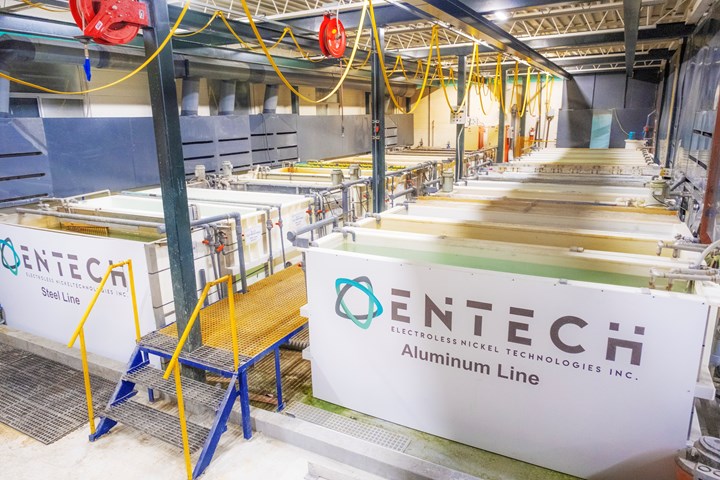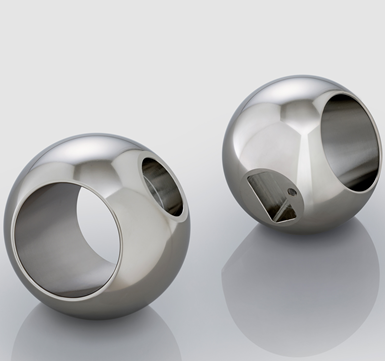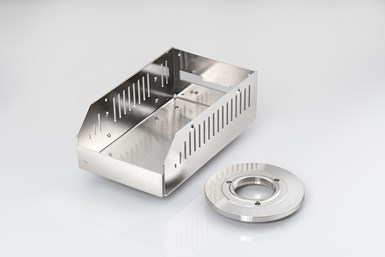
EnTech’s newest capabilities include sulfamate nickel, stainless steel passivation, polytetrafluoroethylene (PTFE) nickel and black nickel.
Photo Credit: EnTech
Electroless Nickel Technologies Inc. (also known as EnTech) got its start in 1999 as a family-owned provider of electroless nickel plating, anodizing and black oxidizing services. Having been involved in the industry since an early age, Kris Pathinather took the reins when his father semi-retired five years ago. Over the years, the company has developed its own black nickel process and has grown through acquisitions.
EnTech’s work is rather diversified, serving a variety of industries including aerospace, nuclear and defense. The company does aerospace maintenance, repair and overhaul (MRO) work, and plates molds and dies for the plastics industry, as well as nuclear power generation (hydrogen power) parts. It also processes parts for valves, mining equipment, and automotive — specifically electric vehicle parts.
Featured Content
Pathinather says EnTech is known for processing larger parts up to 20,000 pounds and 180 inches. The company is also known for plating on exotic alloys.
“We plate on beryllium, copper, tungsten and various grades of stainless steel,” Pathinather says. “We’ve been doing the parts that nobody else wanted, like extreme masking requirements. But that’s made us good at what we do and is one of the reasons why we’ve been growing.”

A high-efficiency boiler from Miura Canada Co. is at the heart of EnTech’s new heating system.
Photo Credit: EnTech
On the move
As EnTech expanded capabilities and acquired technologies it soon found itself needing more space. During the summer of 2021, the company moved into a larger facility.
“We realized our old shop wasn’t big enough,” Pathinather says. “So, we expanded into a new building and set up everything brand new.”
EnTech designed and engineered its own plant, working directly with equipment suppliers to create the material handling system, the PLCs that control the nickel baths, the rectifiers, and even the bussing.
Prior to the company’s move, it was offering three main products:
- Electroless nickel — mid, high, and low phosphorus
- Aluminum anodizing (Type II)
- Black oxide
By September of 2021, EnTech had settled into its new facility and was completely up and running with added capabilities including sulfamate nickel, stainless steel passivation, polytetrafluoroethylene (PTFE) nickel and black nickel. The new facility also features a large sandblast booth and larger tanks for all the processes — an increase from 6 ft. tanks to 10 ft. tanks.
Pathinather says that the increase in the size and number of tanks required EnTech to reassess its heating system. The company was using electric heaters for its tanks. In the new facility, the decision was made to switch to a steam system. A high-efficiency boiler from Miura Canada Co. (Brantford, Ontario, Canada) was installed.
“Our energy costs have gone down even with three or four times the processing volume,” Pathinather says. “That’s been a huge investment that we expect will pay off within a few years.”
EnTech also invested in a new material handling system from Milan Technology Co. Ltd. capable of handling larger parts and a new exhaust system from Fibresteel allowing for an enclosed plating line with push-pull ventilation. With an eye toward increasing its aerospace work, the company also implemented a SoftPlate ERP system to prepare for processing parts for aerospace OEMs.
Chemistry
EnTech is a company that prides itself on trying new things and doesn’t mind being a “guinea pig” for testing new products. Pathinather says, “One of the best parts about our new shop is a lab line that comprises a 200-liter tank line with 14 stations where we can try out new chemistries prior to adoption into our production line.”
EnTech has a longstanding relationship with its chemical supplier Atotech (Rock Hill, S.C.) and has been an early adopter of its green chemistries. A couple of examples of new additions to EnTech’s processes include Atotech’s Nichem HP 1170 and Nichem MP 400.

Atotech’s Nichem HP 1170
Photo Credit: Atotech
Nichem HP 1170 is a sustainable high phosphorus electroless nickel process designed for applications that require high corrosion resistance such as automotive, oil and gas, offshore construction, agricultural and heavy machinery, and the chemical industry. Compared to a standard high phosphorus, this technology provides exceptionally improved corrosion resistance in acidic environments, especially those containing nitrates, chlorides and sulphides. “This new technology represents a big step forward in plating electroless nickel for applications requiring corrosion resistance. To push the corrosion standard higher now means the marketplace can be explored for new plating applications where previously standard high phosphorus technology would not meet the criteria, and that is very exciting,” says Collin Peters, GMF Business Manager for Atotech in North America. In addition, Nichem HP 1170 is lead and cadmium-free and is reported to meet the highest level of environmental compliance.

Atotech’s Nichem MP 400
Photo Credit: Atotech
Nichem MP 400 is a bright, mid phosphorus electroless nickel process forming NiP deposits with high gloss values ranging from 300–600 GU. The process is also lead and cadmium-free and provides the flexibility needed to accommodate a wide range of surface substrates and is suitable for job shops processing a variety of applications such as consumer electronics, appliances, furniture, connectors, medical and automotive parts.
Waste treatment
Environmental responsibility and green initiatives are part of EnTech’s culture. In addition to embracing green chemistries, EnTech is working toward a closed-loop wastewater treatment system. Pathinather says the system is similar to a conventional system with one major change.
The company worked with David Bromley Engineering to replace the clarifier with an RSL membrane (Replaceable Skin Layer Membrane) technology that is said to simplify the water treatment process and that Pathinather has yielded a higher quality treated wastewater.
David Bromley, president of David Bromley Engineering Ltd., describes the technology: “The RSL Membrane technology is a non-barrier membrane. In other words, the membranes filter the solids out of wastewater but the technology does not rely on a barrier like a screen to separate the solids from the water. Instead, it relies on the manipulation of what is known as the electric double layer that is present on colloidal solids. This breakthrough technology simplifies water treatment significantly and provides a 10-fold improvement in the operating speed to treat wastewater.”
Currently, EnTech is treating the water and then discharging it. Pathinather says that ultimately the idea is to close the loop and recycle the water using a high-pressure reverse osmosis (RO) system.
“We’re still fine tuning our treatment,” he says. “The goal in the next few months is to complete this closed-loop process. We hope it saves on our water bill and is better for the environment.”

EnTech got its start in 1999 as a family-owned provider of electroless nickel plating, anodizing and black oxidizing services. Kris Pathinather (left) pictured here with his father Pathinather Philippupillai (right).
Photo Credit: EnTech
Looking forward
EnTech is a nimble operation that has its eye on the future. At the heart of the company’s growth strategy is its eagerness to explore new ways of doing things.
That sense of experimentation is one of the things Pathinather loves about electroless nickel. “I like to really push designers and engineers to spec the EN process. I find that a lot of our customers aren’t aware that you can plate exotic substrates with nickel,” he says.
One of the reasons the company installed the larger tanks is so it can buy the nickel in bulk and bring the price of EN down to make it more popular.“I’d like to continue spreading the word and making it more of a mainstream coating,” he says.
What’s next for EnTech? The company is working toward requirements that would allow it to work with aerospace OEMs — in fact, Pathinather says the company was undergoing its AS9100 audit at the time of this writing and is striving to complete Nadcap certification within the next two years.
Pathinather’s excitement for the industry is infectious. He describes EnTech as a young company and talks with optimism about training newcomers to the industry. The average age of members of EnTech’s team is around 30. Pathinather’s experience combined with the enthusiasm of a young team translates into an eagerness for experimentation and innovation. He puts it simply: “We try to adopt new technologies and we’re not afraid to experiment.”
RELATED CONTENT
-
Masking for Surface Finishing
Masking is employed in most any metal finishing operation where only a specifically defined area of the surface of a part must be exposed to a process. Conversely, masking may be employed on a surface where treatment is either not required or must be avoided. This article covers the many aspects of masking for metal finishing, including applications, methods and the various types of masking employed.
-
Sizing Heating and Cooling Coils
Why is it important for you to know this?
-
Smut and Desmutting
Question: I am new to this industry and have heard about smut and desmutting operations.




















